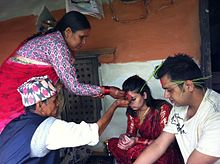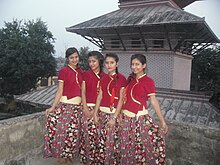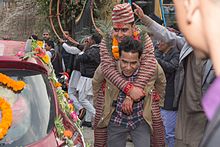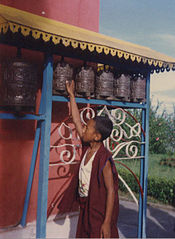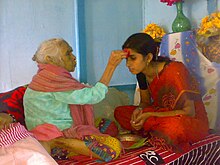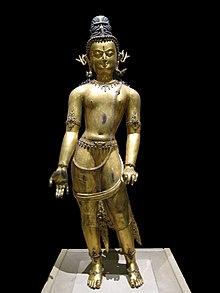
Kathmandu, officially Kathmandu Metropolitan City, is the capital and most populous city of Nepal with 845,767 inhabitants living in 105,649 households as of the 2021 Nepal census and approximately 4 million people in its urban agglomeration. It is located in the Kathmandu Valley, a large valley in the high plateaus in central Nepal, at an altitude of 1,400 metres.
Music of Nepal refers to the various musical genres played and listened to in Nepal. With more than fifty ethnic groups in Nepal, the country's music is highly diverse. Genres like Tamang Selo, Chyabrung, Dohori, Adhunik Geet, Bhajan, Filmi music, Ghazal, Classical music, songs and Ratna music are widely played and popular, but many other less common genres are yet to be cataloged. Western musical genres like Rock, Metal, Hip-Hop, Rap, R&B also regularly feature on the Nepalese music charts. Most of the country's musical bands are based in the Kathmandu valley. Musical genres from Tibet and India have greatly influenced Nepalese music.

Newar, or Nepami, are the historical inhabitants of the Kathmandu Valley and its surrounding areas in Nepal and the creators of its historic heritage and civilisation. Newars form a linguistic and cultural community of primarily Indo-Aryan and Tibeto-Burman ethnicities following Hinduism and Buddhism with Nepal Bhasa as their common language. Newars have developed a division of labour and a sophisticated urban civilisation not seen elsewhere in the Himalayan foothills. Newars have continued their age-old traditions and practices and pride themselves as the true custodians of the religion, culture and civilisation of Nepal. Newars are known for their contributions to culture, art and literature, trade, agriculture and cuisine. Today, they consistently rank as the most economically and socially advanced community in Nepal, according to the annual Human Development Index published by UNDP. Newars are ranked the 8th largest ethnic group in Nepal according to the 2021 Nepal census numbering 1,341,363 people constituting 4.6% of the total population.
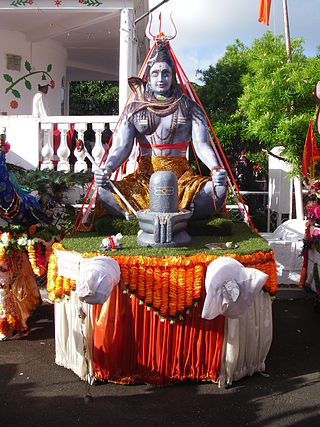
Maha Shivaratri is a Hindu festival celebrated annually in honour of the deity Shiva, between February and March. According to the Hindu calendar, the festival is observed on the fourteenth day of the first half of the lunar month of Phalguna. The festival commemorates the wedding of Shiva and Parvati, and the occasion that Shiva performs his divine dance, called the Tandava.
Ranjitkar is one of the castes of Newar. The Newari caste system is divided according to profession. The Ranjitkar caste is concerned with the dyeing of clothes as well as other color related activities. The word "Ranjitkar" comes from Sanskrit origins crudely meaning "people concerned with colors" whereas the word "Chhipaa" is a Nepal Bhasa compound word which can be roughly translated as "color and allow to dry".
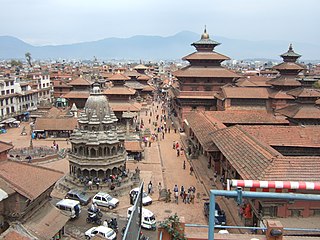
Lalitpur Metropolitan City is a metropolitan city and fourth most populous city of Nepal with 299,843 inhabitants living in 49,044 households per the 2021 census. It is located in the south-central part of Kathmandu Valley, a large valley in the high plateaus in central Nepal, at an altitude of 1,400 metres.

Kirtipur is a Municipality and an ancient city of Nepal. The Newars are the natives of Kipoo (Kirtipur). It is located in the Kathmandu Valley 5 km south-west of the city of Kathmandu. It is one of the five dense municipalities in the valley, the others being Kathmandu, Lalitpur, Bhaktapur and Madhyapur Thimi. It is one of the most famous and religious places to visit. Many people visit this place not only for its natural environment but also to visit temples. The city was listed as a UNESCO tentative site in 2008.
Buddhism in Nepal started spreading since the reign of Ashoka through Indian and Tibetan missionaries. The Kirati people were the first people in Nepal who embraced Gautama Buddha’s teachings, followed by the Licchavis and Newar people. Shakyamuni Buddha was born in Lumbini in the Shakya Kingdom. Besides Shakyamuni Buddha, there are many Buddha(s) before him who are worshipped in different parts of Nepal. Lumbini lies in present-day Rupandehi District, Lumbini zone of Nepal. Buddhism is the second-largest religion in Nepal. According to 2001 census, 10.74% of Nepal's population practiced Buddhism, consisting mainly of Tibeto-Burman-speaking ethnicities and the Newar. However, in the 2011 census, Buddhists made up just 9% of the country's population.

Hinduism is the main and largest religion of Nepal. In 2006, the country declared itself a secular country through democracy, after the abolition of its monarchy. According to the 2021 census, the Hindu population in Nepal is estimated to be around 23,677,744 which accounts for at least 81.19% of the country's population, the highest percentage of Hindus of any country in the world. Vikram Samvat, one of the two official calendars used in Nepal, is a solar Hindu calendar essentially the same to that widespread in North India as a religious calendar, and is based on Hindu units of time.
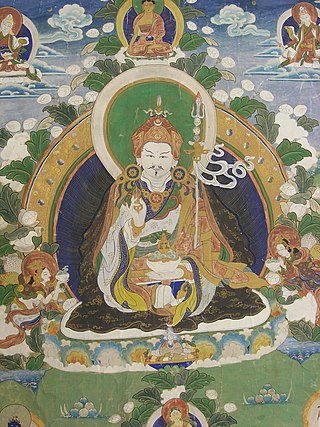
A vajrācārya is a Vajrayana Buddhist master, guru or priest. It is a general term for a tantric master in Vajrayana Buddhist traditions, including Tibetan Buddhism, Shingon, Bhutanese Buddhism, Newar Buddhism.

Kapilvastu District, often Kapilbastu, Birth Place of GAUTAM BUDDHA is one of the districts of Lumbini Province, Nepal. The district, with Kapilbastu municipality as its district headquarters, covers an area of 1,738 square kilometres (671 sq mi) and in 2001 had a population of 481,976, which increased to 571,936 in 2011 and later according 2021 census it further increased to 686,739 Kapilvastu district has 3 number of seats for central whereas 6 seats for state level elections.

Kathmandu District is a district located in Kathmandu Valley, Bagmati Province of Nepal. It is one of the 77 districts of Nepal, covers an area of 413.69 km2 (159.73 sq mi), and is the most densely populated district of Nepal with 1,081,845 inhabitants in 2001, 1,744,240 in 2011 and 2,017,532 in 2021. The administrative headquarters of Kathmandu district is located in Kathmandu. The city has 21 post offices which handle mail from across the country and beyond, with Kathmandu DPO having 44,600 as its postal code for international mail delivery services like UPS or DHL Couriers etc.

The Pashupatinath Temple is a Hindu temple dedicated to Pashupati, a form of Shiva. It is located in Kathmandu, Nepal near the Bagmati River. The temple was classified as a World Heritage Site in 1979. This "extensive Hindu temple precinct" is a "sprawling collection of temples, ashrams, images and inscriptions raised over the centuries along the banks of the sacred Bagmati river", and is one of seven monument groups in UNESCO's designation of Kathmandu Valley. It is built on an area of 246 hectares and includes 518 mini-temples and a main pagoda house.
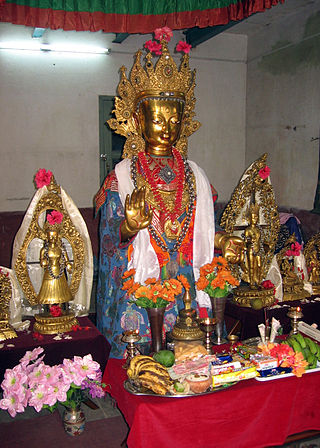
Newar Buddhism is the form of Vajrayana Buddhism practiced by the Newar people of the Kathmandu Valley, Nepal. It has developed unique socio-religious elements, which include a non-monastic Buddhist society based on the Newar caste system and patrilineality. The ritual priestly (guruju) caste, vajracharya and shakya form the non-celibate religious clergy caste while other Buddhist Newar castes like the Urāy act as patrons. Uray also patronise Tibetan Vajrayana, Theravadin, and even Japanese clerics. It is the oldest known sect of the Vajrayana tradition outdating the Tibetan school of Vajrayana by more than 600 years.
Tokha Chandeshwari is a village and former Village Development Committee that is now part of Tokha Municipality in Kathmandu District in Province No. 3 of central Nepal. At the time of the 2011 Nepal census it had a population of 3,961. Tokha Chandeshwari now is part of Tokha municipality.

Asan is a ceremonial, market and residential square in central Kathmandu, the capital of Nepal. It is one of the most well-known historical locations in the city and is famed for its bazaar, festival calendar and strategic location. Asan has been described as a fine Newar example of a traditional Asian bazaar. The Tuladhar, Maharjan, Shrestha, Bajracharya and Shakya castes make up most of the population.

The ancient and refined traditional culture of Kathmandu, for that matter in the whole of Nepal, is an uninterrupted and exceptional meeting of the Hindu and Buddhist ethos practiced by its highly religious people. It has also embraced in its fold the cultural diversity provided by the other religions such as Kirat, Jainism, Islam and Christianity.
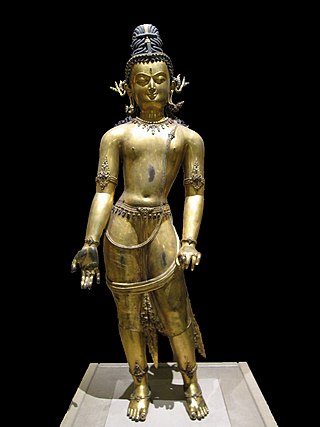
The sculpture of Nepal is best known for small religious figures and ritual objects in bronze or copper alloy, but also has other strengths. The Newar people of Nepal had a long-lasting specialism in casting small bronze figures, mostly religious and especially Buddhist, considerable numbers of which were exported to India and Tibet over many centuries.
Buddhabhumi is a Municipality in Kapilvastu District in the Lumbini Province of southern Nepal. It is located 308 km west of Kathmandu, 47 km west of Butwal and 206 km east of Nepalgung.

Dance is a performing art form consisting of purposefully selected sequences of human movement. Dance (Nepali: नृत्य/ नाच) in Nepal comprises numerous styles of dances, including folk, ethnic, classical to modern dances. Lakhey is the dance of a demon in the carnival of God. Durbar Square, a historic plaza in Kathmandu, Nepal, facing ancient palaces and adorned by Hindu temples, is always full of eager crowds on the last day of Indra Jatra, the festival celebrating Indra, the Hindu king of heaven. In this divine stage, Lakhe the demon dances among gods and deities relentlessly and carelessly.

